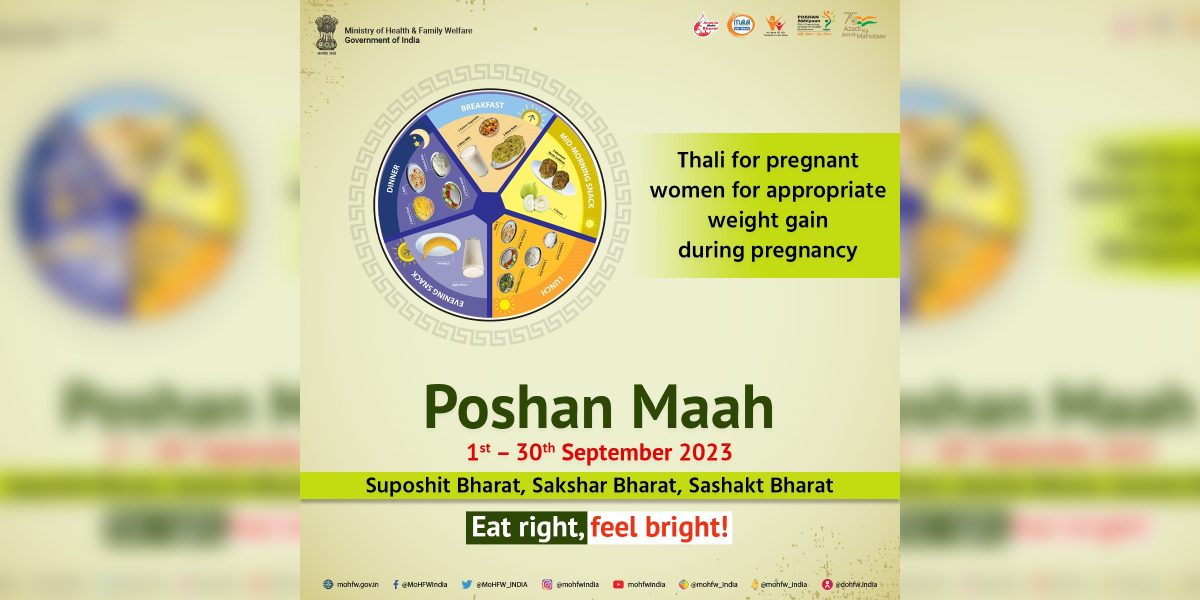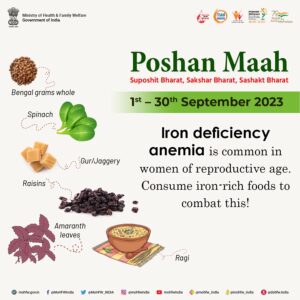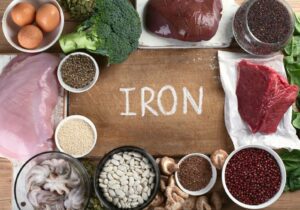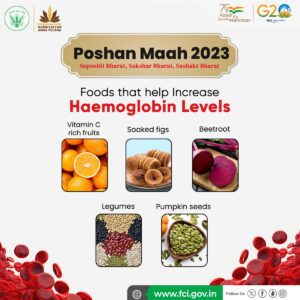The ministry's posters promoting only vegetarian food as source of iron has irked experts: They want to keep politics out of food habits.
Published Sep 23, 2023 | 8:30 AM ⚊ Updated Sep 23, 2023 | 8:30 AM

A poster promoting iron-rich food released by the Union Health Ministry. (Sourced)
“Eat right, feel bright”, goes the tagline of promotional materials the Union Health Ministry has issued to promote Poshan Maah 2023. Nutritionists and health experts, however, do not find the idea either “right” or “bright”.
Instead, they are having beef with what they find is a skewed promotion meant to reap political gains. A prominent hepatologist even found it oxymoronic — the “best worst thing” in a long while.
The Union ministry issued a series of posters and banners with appealing graphics and messages about nutrition, healthy eating, breastfeeding, balanced diet, and related topics on social media platform X (formerly Twitter) to promote Poshan Maah — or nutrition month.
However, it promoted only a plant-based diet.
While experts felt the intention is commendable, the exclusive focus on vegetarian sources for iron raised significant concerns about a balanced diet.
“The messaging for Poshan Maah 2023 mentions vitamin C-rich foods that increase haemoglobin levels — soaked figs, beetroot, legumes, and pumpkin seeds. For a poster spreading a government health education message, it is extremely shocking and shows that science is not the basis for nutrition in India,” said Dr Sylvia Karpagam, community medicine doctor.
Incidentally, Poshan Maah 2023 has “Suposhit Bharat, Sakshar Bharat, Sashakt Bharat” as its slogan.
Poshan Maah is a Union government initiative aimed at promoting awareness about nutrition, healthy eating, and the importance of a balanced diet. It is observed in September every year.
The government, along with various non-governmental organisations, healthcare institutions, and community groups, organise campaigns, workshops, seminars, and awareness programmes throughout the month to educate people about the significance of proper nutrition for individuals and communities.
The objective is to address malnutrition and related issues, especially among women and children. The campaign emphasises promoting breastfeeding, adequate nutrition for pregnant and lactating women, proper infant and child feeding practices, and the importance of consuming diverse and nutritious foods.
The initiative encourages communities to make informed choices about their diet and lifestyle to ensure better health and well-being for all. Various activities during Poshan Maah are designed to raise awareness about the importance of a healthy diet, good hygiene, sanitation, and regular health check-ups.
The Ministry of Women and Child Development also posts video messages and picture messages on social media platforms to promote the same and to prevent anaemia.
The ministry’s posters posit only Bengal gram (whole), spinach, jaggery, raisins, amaranth leaves, and finger millet as sources of iron-rich food that can combat anaemia.

Poster by Government of India to promote iron-rich food to reduce Iron deficiency anaemia. (Supplied)
“To avoid iron-deficiency anaemia, women should include green leafy vegetables and other iron-rich foods in their diet,” the poster said along with the pictures of the above-mentioned food.
While experts appreciated the intention of the Health Ministry they questioned the exclusion of non-vegetarian food from the posters.
Several netizens raised red flags over the posters. “Still there are many people who take you guys seriously! Please don’t provide half-baked info. Include the full list with the best sources (animal-based) on top and let people make an informed decision,” Appy Malik Kandwal said on X.
Another post explained the problem with the poster.
Ministry of health and family welfare @MoHFW_INDIA has released the list of food in its program Poshan Maah which lists women/mother to have food that have high iron content.
As expected it has stirred huge controversy in medical community as it doesn’t include any poultry and… pic.twitter.com/2YA4Y0zFC0
— The Cancer Doctor (@DoctorHussain96) September 22, 2023
Another post criticised the omission of complete sources of iron (meat and fish). “Of course, it doesn’t suit your agenda, nor the dieticians approve of this. Pathetic MoHFW,” X user Shenoy T said.
You must be kidding me. No mention of the actual and complete source of iron (MEAT and FISH!!) Of course it doesn’t suit your agenda nor the dietecians approve of this. Pathetic MoHFW.
— Shenoy T (@am19d001) September 22, 2023
Food and nutrition advocacy expert Dr Karpagam explained that the best sources of iron are organ meat (liver, kidney, and pate) and red meat. She recommended putting them, too, on the posters so that people can choose whether to eat or not.

Indian health ministry’s poster promoting only vegetarian food as source of Iron irks experts, stress importance of keeping politics out of food habits. (Sourced)
Experts also argued that the posters missed an important element of adding vitamin C to these vegetarian options mentioned in the pictures. They pointed out that soaked figs and pumpkin seeds are exotic dishes.
“Vitamin C enhances absorption of iron from food so these foods do not themselves contain iron. Soaked figs and pumpkin seeds are exotic dishes and are not the best source of iron or other nutrients,” Dr Karpagam said.
“Dark-green vegetables contain iron and they should be encouraged to help absorb vitamin C. Many animal source foods like eggs, dairy, chicken, fish, etc, contain good quality proteins and vitamins and minerals that are important to produce haemoglobin,” she added.
Bengaluru-based haematologist Dr Prashanth T provided more insight. “Adding vitamin C containing foods to iron-rich vegetarian foods is essential as it enhances non-heme iron absorption from plant-based foods. Vitamin C transforms non-heme iron into a more absorbable form, combating the lower absorption of plant-based iron,” he told South First.
“This combination improves iron bioavailability and counteracts native inhibitors to iron absorption present in plant foods, aiding in preventing iron -deficiency anaemia. Hence it is important that we add vitamin C along with our vegetarian iron-rich foods,” Dr Prashanth, Associate Professor, Division of Nutrition at St John’s Research Institute, added.
Criticising the Health Ministry for advising women to consume chickpeas, spinach, non-centrifuged cane sugar, amaranth leaves, and finger millets, Dr Abby Philip, popularly known on X as @theliverdr, called it the “best worst” thing on Twitter (X) in a long time.
Terming it “absolute nonsense” Dr Philip posted: “Iron is heme type and non-heme type. Your body can absorb heme iron (from animal protein) more readily and is reported to be up to 18% more bioavailable.”
Non-heme iron — the iron source in vegetarian diets — has an average bioavailability of 5-8 percent.
“The reason is, many plant foods that contain iron also contain phytic acid and oxalates which significantly inhibit the body’s ability to absorb iron,” he said. Dr Philip recommended poultry (chicken, duck), and meat like beef, organ meat, fish, and shellfish as the best sources of iron.
Incidentally, 83.4 percent of men and 70.6 percent of women in the age group of 15 to 49 in India are non-vegetarians, according to the National Family Health Survey-5.
The Indian Health Ministry advising women to consume chickpeas, spinach, non-centrifuged cane sugar, amaranth leaves and finger millets is the BEST WORST thing on Twitter in a long time.
Absolute nonsense.
Iron is heme type and non-heme type.
Your body can absorb heme iron… https://t.co/krZDDFHzm1
— TheLiverDoc (@theliverdr) September 22, 2023
Haematologists and nutritionists argued that the one-size-fits-all approach of advocating a vegetarian-only diet for iron consumption overlooks certain groups of individuals.

Poster by the Government of India to promote iron-rich food to reduce iron deficiency anaemia. (Sourced)
Such groups may struggle to obtain adequate iron levels without the inclusion of heme iron found in animal products.
Pregnant women, children, and individuals with specific health conditions such as anaemia often require higher levels of iron that may be challenging to achieve solely through vegetarian sources, they said.
A senior haematologist, who did not wish to be named, said cultural and geographical diversities must be acknowledged when providing dietary recommendations. Some communities have cultural dietary practices that include meat and other animal products as essential components of their daily meals.
Restricting these dietary preferences to adhere strictly to vegetarianism for iron intake may lead to potential nutritional deficiencies and health complications.
“The promotion of vegetarianism should be part of a broader message promoting a balanced diet that includes a variety of foods to ensure sufficient intake of all essential nutrients, including iron,” he opined.
“A well-rounded approach that educates the public about the importance of balanced dietary choices and encourages the incorporation of iron-rich foods from both vegetarian and non-vegetarian sources would be more prudent and inclusive,” he argued.
He said government health agencies should strive to provide evidence-based, culturally sensitive dietary guidelines that empower individuals to make informed choices according to their unique needs and preferences.
A myopic focus on vegetarianism for iron intake overlooks the diversity of dietary practices, potentially compromising the overall health and well-being of a significant portion of the population, he said.
Poshan Maah should serve as an opportunity to educate the public about the significance of diversity in dietary choices. It should encourage individuals to explore various nutrient-rich foods, encompassing both plant-based and animal-based options.
“By doing so, we can address the nutritional needs of a broader spectrum of the population, considering their unique circumstances and preferences,” he added.
Haematologists unanimously told South First that animal-based food has the highest iron content. However, if a person is a vegetarian then for optimal results, s/he should pair iron-rich foods (E.g., lentils, beans, fortified cereals) with vitamin C sources (E.g., citrus fruits, berries) in the same meal or consume vitamin C-rich foods along with iron-rich vegetarian options to support iron absorption.
Balanced intake and variety ensure effective iron absorption for vegetarians, they pointed out.
Also, if the person is a non-vegetarian then s/he could include red meat, poultry, fish, and seafood as part of her/his daily diet. Additionally, organ meats can be helpful. Pairing these with Vitamin C-rich food like fruits and vegetables can enhance iron absorption.
It may be noted that the Global Hunger Index (2022) has ranked India 107 out of 121 countries — the higher the score, the higher the hunger.
Micronutrient deficiencies are high in low- and middle-income countries, where consuming an energy-dense but nutrient-poor diet exists. People in such countries rely more on low-cost food with limited diversity of diet.
Dr Karpagam highlighted the insufficient variety in India’s food consumption pattern. She stressed the need to move beyond promoting cereals and millet.
She advocated a balanced diet comprising sufficient amounts of milk, eggs, and various types of meat (poultry, fish, red meat), along with vegetables, pulses, legumes, and fats/oils.
“Social stigma in a caste-driven society leads to the exclusion of many iron-rich foods, often dismissing them as tamasic or untouchable, particularly those sourced from animals other than dairy products,” Karpagam added.
